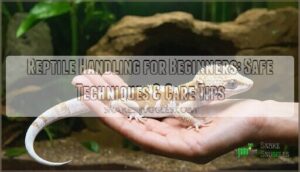This site is supported by our readers. We may earn a commission, at no cost to you, if you purchase through links.

Reptiles communicate through subtle shifts in posture, breathing patterns, and muscle tension that most beginners simply haven’t learned to read yet. This knowledge gap creates most mishaps when interacting, from accidental nips to unnecessary stress for both the person and the animal.
Understanding how to approach, support, and read your reptile transforms these interactions from nerve-wracking gambles into confident, rewarding experiences that strengthen the bond between you and your scaly companion.
Table Of Contents
- Key Takeaways
- Choosing Beginner-Friendly Reptile Species
- Preparing for Safe Reptile Handling
- Step-by-Step Handling Techniques for Beginners
- Recognizing and Responding to Reptile Stress
- Health and Safety for Reptiles and Handlers
- Overcoming Common Handling Challenges
- Frequently Asked Questions (FAQs)
- How do you handle a pet snake?
- How do you handle a snake in a cage?
- How do you acclimate a pet snake to being held?
- How do you handle a tame snake?
- How do you handle a snake if you’re nervous?
- How do you train a snake to be a pet?
- How often should beginners handle their reptiles?
- What time of day is best for handling?
- Can reptiles recognize their owners over time?
- How long does it take to tame a nervous reptile?
- Conclusion
Key Takeaways
- Choosing beginner-friendly species like corn snakes, leopard geckos, or bearded dragons makes all the difference because they’re naturally docile, tolerate handling well, and forgive minor care mistakes while you’re learning proper techniques.
- Supporting your reptile’s body correctly—distributing a snake’s weight along its length, holding lizards under the torso without grabbing the tail, and lifting turtles from the sides—prevents injury and keeps them calm during brief five-to-ten-minute sessions.
- Reading stress signals like hissing, tail-whipping, rapid breathing, or defensive postures tells you when to pause or stop handling, since reptiles communicate discomfort through body language rather than vocalizations most beginners recognize.
- Proper hand hygiene with soap and water for at least 20 seconds before and after every interaction protects you from zoonotic diseases like Salmonella, while regular cleaning of enclosures and surfaces prevents bacterial transmission to family members and other pets.
Choosing Beginner-Friendly Reptile Species
Not all reptiles are created equal in terms of how they’re handled, and choosing the right species makes all the difference. Some reptiles tolerate human interaction naturally, while others need more experience and patience than a beginner should tackle.
Let’s look at the best starter species and what makes them ideal for your first reptile.
Best Reptiles for First-Time Owners
If you’re new to keeping reptiles, picking the right species can mean the difference between smooth sailing and a steep learning curve. Corn snakes, leopard geckos, and bearded dragons top the list of beginner-friendly species because they’re docile, low-maintenance, and forgiving of minor care mistakes.
These safe species won’t break the bank, making reptile care accessible while you learn proper reptile care techniques.
Temperament and Handling Tolerance
Choosing a species is one thing—understanding its temperament is another. Some reptiles tolerate interaction well, while others see your hand as a threat. Corn snakes and leopard geckos usually stay calm during brief sessions, but even docile individuals show stress signals like rapid breathing or tail-whipping when you pick them up too long.
Individual variation matters more than you’d think—two bearded dragons from the same clutch can react completely differently to the same approach. Watching animal behavior and building trust through consistent, gentle interaction helps your reptile adjust to being picked up over time.
Approaching reptiles slowly can reduce stress, as gentle handling techniques are essential.
Key Habitat and Care Requirements
A reptile that tolerates being held won’t thrive if you can’t replicate its natural environment—temperature gradients, humidity levels, and enclosure size matter just as much as temperament when you’re choosing your first species.
Corn snakes need a 75–85°F warm zone with proper substrate types for burrowing, while leopard geckos require dry conditions and hiding spots.
Your reptile enclosure setup must match species needs—lighting needs vary widely, and environmental enrichment keeps your animal healthy between handling sessions.
Ethical Sourcing and Captive-Bred Options
Once you’ve nailed habitat basics, where your reptile comes from matters more than you’d think. Over half of all reptiles traded globally are still wild-caught, but captive-bred specimens adapt better to being held, carry fewer parasites, and help conservation efforts.
For beginners, captive-bred animals are healthier and calmer—online marketplaces show less than 1% wild-caught ads, reflecting market trends toward ethical sourcing. These animals are born in captivity to captive bred parents.
Preparing for Safe Reptile Handling
Before you bring your reptile into your hands, you need to set the stage for success. A little preparation goes a long way in keeping both you and your new companion safe and comfortable.
Let’s walk through the essentials you’ll want in place before that first interaction.
Setting Up a Calm Environment
Before you ever open the enclosure, think of your reptile’s perspective—sudden movements, loud sounds, and bright overhead lights can turn a routine interaction session into a panic-inducing ordeal. Creating a comfortable environment means establishing a quiet zone with stable environmental conditions, proper temperature gradients, and visual barriers that let your reptile retreat to hiding spots during acclimation.
Key elements for a calm space for interaction:
- Minimize noise and foot traffic around the secure enclosure before approaching
- Dim overhead lighting to reduce stress and allow natural behavior
- Provide hiding places so your reptile feels safe, not cornered
Essential Tools and Safety Gear
Having the right gear on hand isn’t just about convenience—it’s your insurance policy against stressed-out reptiles and potential bites. Start with a sturdy snake hook for safe distance, thick gloves in leather or puncture-resistant materials for bite prevention, and tongs with appropriate length for larger species.
Don’t overlook eye protection and protective clothing when interacting with defensive reptiles—these tools transform risky encounters into controlled, confident interactions.
Hand Hygiene and Disease Prevention
While your new reptile might look clean, it can still harbor bacteria like Salmonella—making proper hand hygiene your first line of defense against zoonotic disease.
Follow these essential steps to prevent disease transmission:
- Wash hands thoroughly with soap and warm water for at least 20 seconds before and after touching
- Avoid touching your face during interactions to block pathways for bacterial transfer
- Disinfect enclosures and surfaces using pet-safe cleaners after every session
Consider wearing disposable gloves when interacting with wild-caught specimens for added protection.
Supervising Children and New Handlers
Children and reptiles can be a wonderful combination, but only when you’ve laid the groundwork for safe, supervised interactions that protect both parties. Teach gentle acclimation through demonstration first, then guide their hands while they practice. Never leave children unattended—even "easy" species can bite when frightened.
| Safety Precautions | Child Safety Rules | Confidence Building |
|---|---|---|
| Always stay within arm’s reach | No sudden movements or loud noises | Start with calm, docile species |
| Demonstrate proper support techniques | Wash hands before and after | Praise correct acclimation techniques |
| Watch for reptile stress signals | Don’t touch near face or mouth | Gradually increase interaction time |
| Intervene if acclimation mistakes occur | One child interacts at a time | Explain reptile body language clearly |
This supervised acclimation benefits everyone—kids learn responsibility while your reptile stays stress-free, following proven reptile interaction guidelines that prevent accidents.
Step-by-Step Handling Techniques for Beginners
Once you’ve got your setup ready and your mindset calm, it’s time to actually pick up your reptile. The key is knowing how to approach, support, and interact with different species without stressing them out.
Let’s walk through the basics so you can feel confident every time you interact with your scaly companion.
Approaching Reptiles Calmly and Confidently
Your reptile won’t read your nerves, but it’ll definitely feel them—calm hands and slow movements are the difference between a successful interaction and a defensive snap. Approach calmly and confidently, lowering yourself to their level rather than looming overhead.
Watch for reptile signals like hissing or tail-whipping, which tell you to pause. These calming techniques reduce fear and build trust, turning safe interaction into second nature as you learn reptile behavior.
Supporting The Body—Snakes, Lizards, and Turtles
Think of it this way: supporting a reptile’s body properly isn’t just good manners—it’s the foundation of every safe interaction, and each species has its own blueprint for feeling secure in your hands.
Proper body support isn’t courtesy—it’s the foundation of safe reptile handling, with each species requiring its own specific technique
When interacting with snakes, support their body along its length, distributing weight evenly. For lizards, hold under the torso, never grabbing the tail. Turtles need gentle lifting from the sides, avoiding limbs entirely—this prevents injury and keeps them calm.
Minimizing Handling Time to Reduce Stress
Even with perfect support, the real secret to stress-free interaction is keeping sessions short—reptiles don’t enjoy being held the way a dog might, and a few minutes in your hands can feel like an eternity to them. Aim for five to ten minutes maximum per session, watching for signs of reptile stress like rapid breathing or struggling.
Efficient techniques and gradual acclimation build trust over time, making routine contact positive rather than overwhelming for safe interaction with reptiles and amphibians.
Using Hooks, Gloves, and Other Equipment
When your management technique needs a little backup—or when you’re working with a species known for defensive strikes—the right tools can make all the difference between confidence and chaos. Snake hooks and thick gloves keep your hands safe from defensive bites, while protective clothing adds another layer of security when managing reptiles safely.
Match hook size to your animal’s length, choose glove material that balances protection with dexterity, and practice equipment training before live sessions. Regular tool maintenance ensures everything works smoothly when it counts.
Recognizing and Responding to Reptile Stress
Reptiles can’t always tell you when they’re uncomfortable, but their bodies will. Learning to read stress signals and knowing how to respond can prevent bites, injuries, and long-term health problems for your pet.
Here’s what to watch for and how to adjust your approach when your reptile needs a break.
Signs of Aggression Vs. Defense
Because reptiles lack facial expressions like mammals, reading their body language becomes essential for distinguishing between fear-based defense and actual aggression. Understanding reptile behavior helps prevent bites during reptile interactions. Watch for these defensive behaviors and stress signals when interacting with them:
- Defensive Postures and Threat Displays – Puffing up, flattening the body, or gaping the mouth signals a reptile feels cornered and wants you to back off.
- Vocalizations and Strike Distance – Hissing, rattling, or positioning within striking range means the reptile is warning you to keep away.
- Tail Movement and Body Language – Rapid tail whipping, coiling tightly, or thrashing indicates high stress and readiness to defend itself.
Adjusting Handling Techniques
Once you spot these warning signs, adapting your approach on the spot can mean the difference between a smooth interaction and a defensive strike. Slow your movements, increase your distance, and give the reptile space to settle.
Building trust takes time, and species-specific nuances matter—some reptiles recover quickly, while others need longer breaks. Adjust interaction frequency based on temperament changes and environmental factors, refining your technique with each session.
When to Pause or Stop Handling
Sometimes the best lesson isn’t about what to do—it’s knowing when to walk away and let your reptile reset. Recognizing excessive stress signs—like prolonged hissing, tail lashing, or refusal to settle—means it’s time to end the interaction. Caretaker anxiety can escalate physiological stress, creating a feedback loop that increases injury risk.
Stop interacting immediately if:
- Your reptile shows uncooperative behavior despite adjusting techniques
- Environmental factors (noise, temperature) are causing distress
- You feel uncertain or rushed, compromising stress management
Trust your instincts—giving your animal space protects both of you.
Health and Safety for Reptiles and Handlers
Keeping your reptile healthy—and keeping yourself safe—means knowing what to watch for and how to prevent problems before they start. From spotting early warning signs of illness to protecting against disease transmission, a few simple habits go a long way.
Let’s walk through the essentials you need to interact with reptiles responsibly and respond quickly when something’s off.
Common Health Issues and Warning Signs
Keeping your reptile healthy starts with spotting trouble early. Respiratory problems like wheezing or open-mouth breathing signal infection, while skin infections appear as discoloration or lesions. Watch for metabolic bone disease—soft shells or limb deformities—and anorexia signs like refusing food for weeks.
Parasite detection requires fecal exams, but you’ll notice weight loss or lethargy first. Recognizing emergency signs and symptoms helps you act fast when reptile health issues arise.
Preventing Zoonotic Disease Transmission
Beyond basic hygiene lies the real defense against zoonotic diseases like Salmonella and bacterial infections.
Wash your hands with soap for at least 20 seconds before and after touching—it’s non-negotiable. Wear disposable gloves when working with wild-caught specimens or cleaning enclosures, then disinfect surfaces using reptile-safe products. Never touch your face during sessions.
Schedule regular veterinary checkups to catch disease symptoms early, protecting both you and your pet from preventable transmission risks.
First Aid Kit and Emergency Procedures
A well-stocked first aid kit isn’t just a precaution—it’s your frontline response when accidents happen, whether it’s a defensive bite or a holding mistake.
Keep these essentials ready:
- Sterile gauze and bandages for reptile bite care and wound management
- Antiseptic solution to clean minor injuries and prevent infection
- Emergency veterinarian contact information for toxin exposure, fracture care, or prolapse repair situations
Know your limits—venomous bites, burn treatment, and serious injuries require immediate professional intervention, not home remedies.
Cleaning and Disinfecting After Handling
Every interaction session ends the same way—your hands, surfaces, and equipment need thorough cleaning to prevent Salmonella and other bacterial threats from spreading to you, your family, or other pets.
Wash hands with soap and warm water for at least 20 seconds—hand sanitizer won’t cut it for reptile hygiene.
Use safe disinfectants on countertops, tools, and enclosure surfaces, practicing proper waste disposal to prevent cross-contamination. Tool sanitation matters just as much as surface cleaning.
Overcoming Common Handling Challenges
Even the most docile reptiles can test your patience from time to time. You might encounter a snake that refuses to cooperate, a lizard that seems perpetually on edge, or a turtle that retreats at your slightest movement.
Here’s how to work through these challenges and build a better relationship with your reptile.
Building Trust With Skittish or Feisty Reptiles
Trust isn’t built overnight with a nervous reptile—it’s earned through patience, consistency, and a willingness to read their body language like a second language. Start with short, supervised interaction sessions, keeping your movements slow and predictable. Consistent routines help skittish reptiles anticipate what’s coming, minimizing stress.
Gentle introduction means letting them come to you when possible, rather than forcing contact. Over time, positive reinforcement—like offering food after picking them up—teaches them you’re not a threat.
Preventing and Managing Bites
Even with the best approach, bites can happen—but understanding why reptiles bite and how to respond can turn a scary moment into a manageable one. Most bites stem from mistakes in how you hold them—moving too fast, grabbing without warning, or misreading defensive signals.
Bite prevention means respecting their boundaries and using safe restraint practices. If bitten, stay calm and gently remove the animal without jerking.
Clean wounds immediately with soap and water, apply antibiotic ointment, and monitor for infection or unusual symptoms that warrant medical attention.
Consulting Experts for Persistent Problems
When challenges persist despite your best efforts, reaching out to a veterinarian or experienced herpetologist can make all the difference. Expert consultations provide sophisticated diagnostics and second opinions on behavioral issues that you can’t solve alone. A specialized vet familiar with reptile behavior can identify underlying health problems affecting temperament, while a reptile behavior expert offers specific techniques for your particular situation.
When to consult a reptile expert:
- Your reptile shows persistent aggression despite consistent, gentle interaction over several weeks
- You notice unusual physical symptoms alongside difficult behavior—lethargy, weight loss, or changes in feeding
- Standard techniques fail repeatedly, and you’re concerned about your safety or the animal’s welfare
Frequently Asked Questions (FAQs)
How do you handle a pet snake?
Support your snake’s body along its entire length, using both hands to distribute weight evenly.
Move slowly and confidently, avoiding sudden movements that might trigger defensive snake behavior or stress responses.
How do you handle a snake in a cage?
Use a snake hook for cage approach, gently lifting the snake’s mid-body to assess snake temperament and prevent escape.
Support its body fully, watch for defensive snake behavior, and secure the snake enclosure post-handling for snake safety.
How do you acclimate a pet snake to being held?
Like training wheels on a bike, gradual introduction is key. Start with five-minute sessions every few days, using positive reinforcement after each successful interaction.
Watch for signs of comfort—relaxed body language and calm movement—while avoiding triggers like sudden grabs or excessive touching frequency.
How do you handle a tame snake?
To interact with a tame snake, approach slowly and support its body with both hands, securing a firm grip.
Observe the snake’s body language for comfort, and keep interaction sessions brief to minimize stress.
How do you handle a snake if you’re nervous?
Nervousness is like static on a radio—it interferes with clear signals between you and the snake. Start with calming techniques: breathe slowly, observe snake body language from a distance, and rely on tools like hooks initially.
Gradual exposure builds confidence while understanding snake behavior and temperament reduces anxiety, helping you interpret snake signals accurately and achieve snake stress reduction through proper snake care.
How do you train a snake to be a pet?
Snakes don’t "train" like dogs, but you can build trust through consistent, gentle interaction frequency, positive reinforcement via calm interactions, and understanding snake behavior.
Desensitization methods help reduce snake stress, while recognizing snake body language ensures you’re building trust with your reptile effectively.
How often should beginners handle their reptiles?
Like a slow dance between predator and prey, the balance of interaction frequency depends on species differences and individual needs.
For most beginners, two to three brief interaction sessions weekly allows habituation benefits while keeping stress levels manageable, with minimal interaction preferred initially.
What time of day is best for handling?
Circadian rhythms and temperature influence determine best times. Most reptiles are most active during their natural peak periods—morning for diurnal species, evening for nocturnal ones.
Avoid interactions after feeding due to digestion impact.
Can reptiles recognize their owners over time?
Reptile cognition varies widely, but many species can learn to recognize their owners through sensory perception—primarily scent and visual cues.
This learned behavior strengthens with consistent, positive interaction, though individual variation means some reptiles bond more readily than others.
How long does it take to tame a nervous reptile?
Taming timelines vary—some reptiles respond within weeks, while others need months of patience and consistent interaction.
Environmental factors, positive reinforcement, and gentle interaction techniques all influence progress, but individual variation means there’s no universal answer.
Conclusion
Like a blacksmith tempering steel, every successful interaction with your reptile strengthens the connection between caregiver and animal. Reptile interaction for beginners doesn’t demand flawlessness—it requires patience, observation, and respect for a creature that operates on instinct rather than affection.
Watch your reptile’s body language, support its weight properly, and recognize when stress signals appear. These foundational skills transform anxious encounters into confident exchanges. Your trembling hands will steady with practice, replaced by the quiet assurance that comes from truly understanding the animal in your care.
- https://pmc.ncbi.nlm.nih.gov/articles/PMC7525537/
- https://community.morphmarket.com/t/percentage-of-wild-caught-and-imports/18359
- https://showmereptileshow.com/resources/breeding-reptiles-in-captivity-a-sustainable-bridge-to-conservation
- https://www.humaneworld.org/sites/default/files/docs/reptile-trade-export.pdf
- https://www.smithsonianmag.com/science-nature/quarter-all-reptile-species-many-them-endangered-are-sold-online-180975937/














